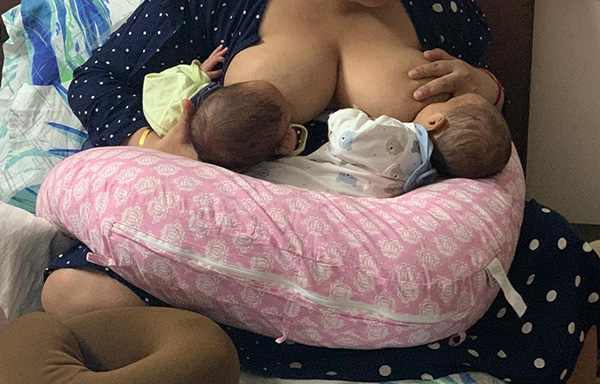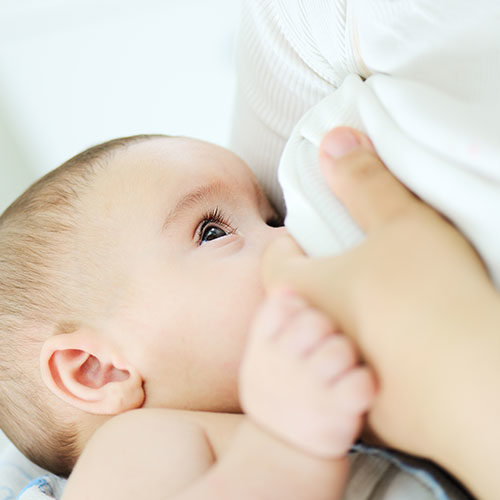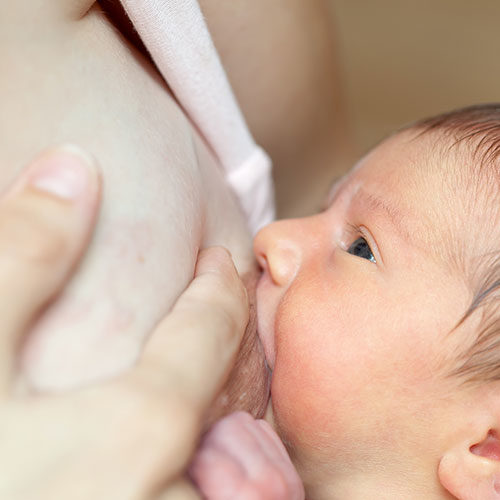Is it possible to breastfeed more than 1 baby at a time? How can it be done?
As the name suggests, breastfeeding multiples involves nursing more than one baby in the same time-span. It does not necessarily mean that two or more babies should be nursed simultaneously at the same moment. What it means is that the mother’s body is making milk for two or more babies and she is nursing them both in a specific given time-frame.
Breastfeeding multiples covers both –
- Breastfeeding twins or triplets
- Breastfeeding older and younger child
Breastfeeding Twins
Can a mother make enough milk?
Mothers who give birth to twins can also make milk for both of their babies. The simplest explanation here is that – our milk production is hormone driven in the initial phase. During this time, most mothers (except those who are having certain medical conditions that can potentially hinder their milk-making ability/capacity) make much more milk than what is needed. Therefore, even mothers of twins make enough milk for both their babies. Once the mature milk comes in, the demand and supply rule kicks in. The mother starts making as much milk as is removed from her body. So, a mother of twins will have double the demand and her body will respond to that demand by providing double the supply. Always remember that – The milk is multiplied for two, and not divided by two.
Supply = Demand |
Read our article on milk production here for a better understanding.
Providing expressed breast milk (EBM) for twins:
In some cases, a mother might have to provide expressed breast milk (EBM) to one or both of her babies.
- When the twin babies are born preterm and are in the NICU or are unable to latch.
- When they are born full-term, one or both of the babies are separated from the mother due to NICU admission.
- When one or both of the babies are underweight and unable to latch.
When babies are not breastfeeding directly, the demand is not getting conveyed to the mother’s body by direct breastfeeding. Therefore, it is important to regularly express milk. Following tips can be very helpful while expressing milk for twin babies.
- Start expressing as early as possible after birth – within 24 hours at least.
- Express at least 10-12 times in 24 hours.
- Express from both breasts every time to convey more demand.
- Shorter, frequent sessions of expressing milk are more likely to increase the milk-production to meet the needs of both the babies.
Should each baby be nursed at a designated breast?
Reserving one breast for a particular baby and the other breast for her twin is not necessary. However, what is important is that –
- Each baby should be draining the breast at the time of feeding. Switching babies in between might keep the babies from getting the hind milk which is important for gaining weight.
- Each breast should get equal opportunity to be nursed at. It is important to ensure this when the twins are nursing separately at separate times.
- In the initial days, it could be a good idea to switch babies from one side to the other at alternate feedings.
Nursing positions that are helpful in breastfeeding twins:
When each baby is nursing separately, it is easier to nurse the baby in any position the mother might feel comfortable in. The challenge appears when both the babies want to nurse at the same time. Following positions come in handy at such times.
- Double Football Position –
Nursing both the babies together in the football hold position is a very efficient and convenient way to nurse twins together. Nursing pillows or even regular pillows can be used to aid this position. Once baby-1 has latched, baby-2 can be latched on to the other breast.
- Laid-back Position –
This is another position which can be used to nurse twins simultaneously. In the initial days, the mother might need help and support from someone to hold babies in place.
- Double Cradle Position –
This position can be very comfortable once the babies are a little older and can retain the latch by themselves.
- Nursing lying down –
Lying down flat on the back and nursing is a very convenient position for a sleep deprived, exhausted mother. But it’s a little tricky to nurse twins in this position. In the initial days (until babies develop good neck control), it is advised that someone else should be present to support the mother and hold the babies in position. Once babies are a little older, develop head control and learn to roll both ways, they can manage to retain the latch and/or relatch by themselves. It becomes easier for the mother to support the babies as well.
- Side-lying Position –
This is a little tricky with twins, but possible once they are a little older. The mother must take the judgement based on the size of her breasts, size of each baby and length of each baby’s arms.
- One child in cradle hold and one in football hold position can work too.
- The modified lying down position in which the babies are positioned from over the mother’s shoulders is useful for the mothers who have undergone a c-section to deliver her babies. This position will require constant assistance for the mother to hold babies in place.
Other Tips:
- Some mothers sometimes express their milk and offer it to one of the twins while nursing the other one directly. This can be helpful in initial days when the mother is too tired and may be wanting to catch up with some rest and sleep while nursing one baby in the side-lying position.
- In most cases, even though it takes some practice, nursing twins simultaneously saves a lot of time.
- While nursing in public, nursing each twin separately could be more convenient. However, practice can help a mother be comfortable to tandem-nurse even in public.
Tandem Nursing older and younger child
After continuing to nurse the older baby through pregnancy, many mothers continue to nurse her along with the newborn. This is called tandem-nursing older and younger children.
Can a mother make enough milk?
Just like in the case of twins, in the case of tandem-nursing too, a mother can produce enough milk for both the older child as well as the younger child. Since the supply of breast milk is determined by the demand, when both children are breastfeeding, the body produces the milk to meet both their demands. Therefore, the milk will not get divided among the two, but will be multiplied for them both.
Should each baby be nursed at a designated breast?
It is not necessary, but some women have done it – especially when one of the kids is going through an illness. It is fascinating to find that the breast that is reserved for the sick child produces yellower and thicker milk – resembling colostrum – full of antibodies.
Tandem – Nursing Positions :
- Double football hold
- Double cradle hold (Younger baby’s feet resting on the older child)
- Combination of football and cradle hold (one child in football hold and the other in cradle hold)
- Side-lying Position (Younger baby on the bed and the older child perched on the mother’s side)
- Combination of side-lying and pop-over nursing position (younger baby in traditional side lying position and the toddle kneeling from behind, dipping her head down in the pop-over position.
- Other nursing positions and their combinations can be tried out to check what works!
Can EBM be offered to the weaned, older child?
A lot of mothers face this dilemma. Sometimes the older child weans during pregnancy due to the dip in supply, mother’s aversions or other reasons. If the mother wishes to breastfeed the older baby after the birth of the newborn, she could try to latch the older child. If the child has forgotten to latch or refuses the breast for whatever reason, the mother could offer her EBM (expressed breast milk) to the older child. This way, the child continues to receive the benefits of the mother’s milk and the mother too can produce enough for both if she sets a regular routine of hand-expressing or pumping.
Other Tips:
- It is important to remember that the younger baby should always get the preference in nursing.
- If the older child is also very small, it is important to meet her needs too, by not just breastfeeding but even by spending time with her.
- While nursing both of them together, the newborn should be taken care of as to not get hurt by the other nursling.
References:
https://www.llli.org/two-breastfeeding-twins-2/
https://www.lllc.ca/sites/default/files/462_CMYK_2015_FINAL.pdf
https://kellymom.com/ages/newborn/bf-basics/bf-links-multiples/


Wish to speak with a member of our team who is a certified lactation professional and also an experienced breastfeeding mother, click on this link.
Medical Advice Disclaimer
THIS WEBSITE DOES NOT PROVIDE MEDICAL ADVICE.
The information, including but not limited to, text, graphics, images and other material contained on this website are for informational purposes only. No material on this site is intended to be a substitute for professional medical advice, diagnosis or treatment. Always seek the advice of your physician or other qualified health care provider with any questions you may have regarding a medical condition or treatment before undertaking a new health care regimen, and never disregard professional medical advice or delay in seeking it because of something you have read on this website.
Disclaimer
We understand and acknowledge that parents and babies can be of various genders on a spectrum of LGBTQI+. Families come in diverse flavours. However, in our articles, for the sake of simplicity and convenience, we will be referring to the breastfeeding parent as the mother and using the female pronouns- ‘she’ and ‘her’ for babies. Babies can be nourished and nurtured in different ways and while we have used the terms breastfeeding and nursing, we recognize that parents can opt to chest feed or finger feed.
We don’t have conflicts of interest and declare, and we are compliant with the WHO code of marketing of breastmilk substitutes and the IMS act.
In case you find any information on this website that needs to be updated, please write to us at info@bsim.org.in






